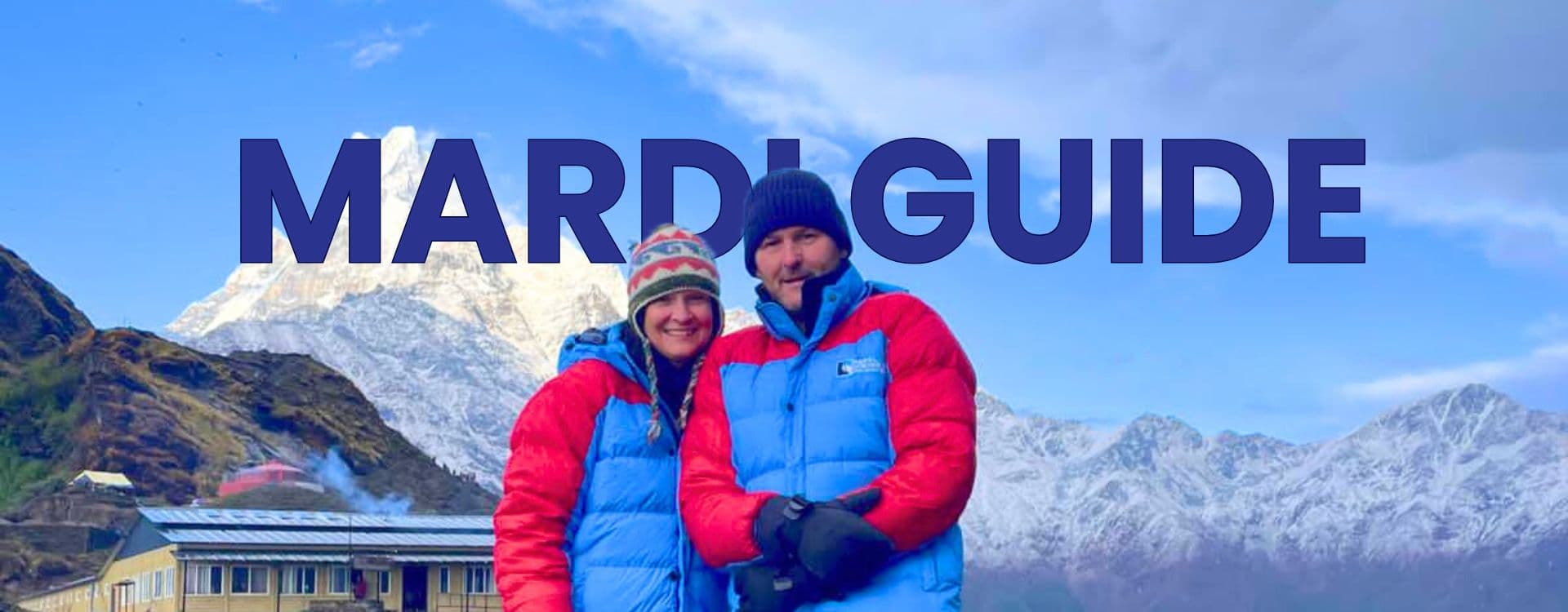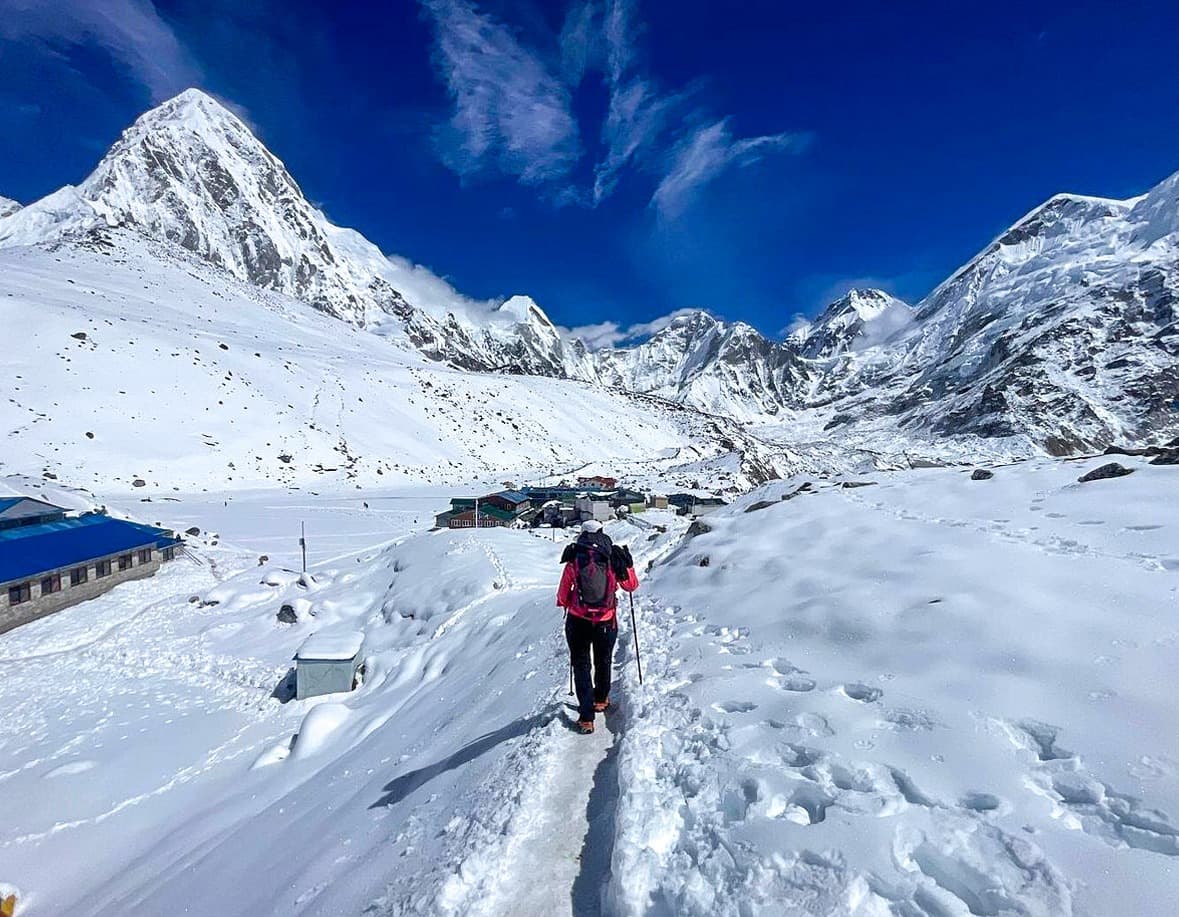- Mardi Himal Trek Highlights
- Reasons to choose Mardi Trek
- When is the best time for the Mardi Himal Trek?
- How difficult is Mardi Trek?
- Mardi Himal Trek Required Permits
- How Long is Mardi Trek?
- Food and water on the Mardi Himal Trek
- Accommodation for Mardi Himal Trekking
- Money during Mardi Himal Trek
- Encountering Mules at Mardi Himal Trek
- Solo Trekking for Mardi Himal Trek
- Restroom during Mardi Himal Trek
- Hot Shower During Mardi Himal Trek
- Trekking Alternatives to the Mardi Himal Trek
- Trekking Routes to Mardi Himal Trek
- Guides and Porters for Mardi Himal Trek
- Travel Insurance for Mardi Himal Trek
- Mardi Himal Trek Concluding Notes - Nepal Hiking Team
The Mardi Himal Trek is one of Nepal’s most enchanting short treks, offering a perfect blend of breathtaking scenery, cultural immersion, and off-the-beaten-path adventure. Nestled in the Annapurna region, this trail reveals panoramic views of Machhapuchhre (Fishtail), Annapurna South, and Hiunchuli, all within a few days of walking. Unlike busier routes such as Annapurna Base Camp or Ghorepani Poon Hill, Mardi Himal remains peaceful and intimate, allowing trekkers to experience the serene beauty of the Himalayas with fewer crowds and a genuine connection to local life.
This complete guide to the Mardi Himal Trek covers everything you need to know, from permits and transportation to food, accommodation, and trekking tips. Known for its beginner-friendly trail and flexible itinerary, this journey is ideal for those seeking authentic Himalayan adventure without long durations or extreme altitudes. Along the way, you will encounter traditional Gurung villages, vibrant rhododendron forests, and ridge-top trails that lead to some of the most rewarding viewpoints in the Annapurna range. The Mardi Himal Trek stands out for its balance of accessibility, beauty, and tranquility, making it one of Nepal’s most captivating trekking experiences.
Mardi Himal Trek Highlights
The Mardi Himal Trek is one of Nepal’s most rewarding short treks, combining natural beauty, cultural richness, and peaceful mountain trails. Its moderate difficulty makes it suitable for trekkers of all ages, including families and beginners. The route reaches an altitude of about 5,587 meters, offering close-up views of Machhapuchhre (Fishtail), Annapurna South, Hiunchuli, and several neighboring peaks that create an awe-inspiring Himalayan panorama.
The trail is truly an off-the-beaten-path experience, winding through rhododendron forests, terraced farmlands, and traditional Gurung villages. Each step reveals changing landscapes, from lush green hills to rocky alpine ridges. The calm and simplicity of the journey allow trekkers to connect deeply with nature and enjoy the quiet beauty of the mountains.
Although it is one of the newer trekking routes in Nepal, the Mardi Himal Trek captures the essence of authentic Himalayan exploration. It offers a rare balance between adventure and cultural immersion, giving travelers a chance to witness daily life in the highlands of the Annapurna region. Along the way, you will meet friendly locals from diverse ethnic groups, including Gurung, Magar, Rai, Brahmin, and Chhetri, whose hospitality and traditions make the journey even more memorable.
With breathtaking viewpoints, scenic trails, and warm local encounters, the Mardi Himal Trek promises an experience that reflects the true spirit of trekking in Nepal, filled with beauty, serenity, and cultural discovery.

Reasons to choose Mardi Trek
The Mardi Himal Trek offers a rare combination of tranquility, cultural authenticity, and mountain grandeur in Nepal’s Annapurna region. It’s ideal for trekkers seeking a quieter alternative to the more crowded routes, providing meaningful encounters with nature and local life without requiring a long or demanding itinerary.
- Less Crowded Experience:
Unlike the popular Annapurna or Everest Base Camp trails, the Mardi Himal route remains peaceful and relatively undeveloped. Its quiet paths lead through pristine forests and open ridges, offering a genuine sense of solitude in the Himalayas. - Authentic Local Culture:
The trek passes through traditional Gurung and Magar villages where travelers can experience genuine Nepali hospitality. Staying in small teahouses reveals the daily rhythms, customs, and warmth of mountain life. - Magnificent Mountain Views:
Although shorter than other treks, Mardi Himal rewards adventurers with close-up panoramas of Machhapuchhre, Mardi Himal, and the Annapurna range. The sunrise views from High Camp are especially memorable. - Short and Accessible Journey:
With a total duration of about a week, this trek suits those with limited time or anyone seeking a rewarding yet manageable Himalayan experience. - Moderate Challenge, High Reward:
The route reaches an altitude of around 4,500 meters and is graded as moderate, offering a comfortable balance of adventure and accessibility with minimal risk of altitude sickness. - Diverse Landscapes:
From terraced farmlands and rhododendron forests to rugged alpine ridges, the trail unfolds a striking variety of scenery within a compact distance. - Springtime Beauty:
April brings a spectacular display of blooming rhododendrons along the trail, adding a vibrant burst of color to the already dramatic Himalayan backdrop.
When is the best time for the Mardi Himal Trek?

The Mardi Himal Trek is open year-round, and each season offers its own beauty and atmosphere. Weather, trail conditions, and visibility can vary greatly, so choosing the right time helps ensure the best experience on the trail.
| Season | Months | Weather & Temperature | Trail Conditions | Scenery & Experience | Suitability |
|---|---|---|---|---|---|
| Spring | March to May | Mild days and cool nights with mostly clear mornings. | Dry and stable trails lined with blooming rhododendrons. | Crystal-clear views of Annapurna, Machhapuchhre, and Dhaulagiri with colorful landscapes. | Excellent for photography, mountain views, and comfortable trekking. |
| Summer / Monsoon | June to August | Warm and humid with frequent rainfall. | Trails can be muddy and slippery, and visibility is often limited. | Lush green hillsides and quiet paths with few trekkers. | Suitable for those seeking solitude and do not mind rain. |
| Autumn | September to November | Cool temperatures, clear skies, and calm weather. | Dry, well-defined trails with ideal hiking conditions. | Panoramic mountain views and vibrant local festivals. | Perfect for clear views, cultural experiences, and stable weather. |
| Winter | December to February | Cold mornings and nights with crisp, clear days. | Dry trails with light snow at higher altitudes. | Peaceful environment and unobstructed views of the peaks. | Best for experienced trekkers who enjoy quiet trails. |
Although Mardi Himal is accessible all year round, spring (March to May) and autumn (September to November) are considered the best seasons. These months provide pleasant temperatures, clear skies, and the most breathtaking Himalayan views, offering the perfect balance between adventure and comfort.
How difficult is Mardi Trek?
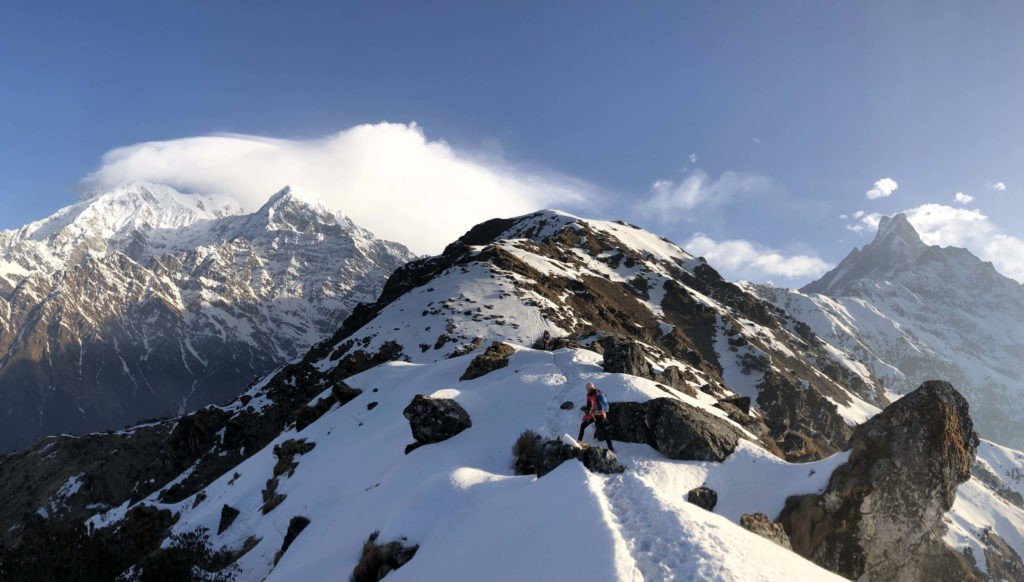
The Mardi Himal Trek is considered easy to moderate in difficulty. It does not require any technical climbing skills, making it suitable for beginners who have a basic level of fitness and a passion for mountain trekking.
The trail is well-marked and maintained, though parts of it can be physically demanding due to its natural terrain. Much of the walking path consists of stone steps, which involve continuous ascending and descending. This gradual climb and descent help with natural acclimatization to the increasing altitude.
Trekkers typically walk five to seven hours per day, depending on pace and rest breaks. The most challenging section lies between the Upper Viewpoint and Mardi Himal Base Camp, where the trail becomes steep and narrow. This stretch demands careful footing and good stamina, particularly when the weather is cold or windy.
During winter, conditions can be tougher. Snowfall is common from Forest Camp onward to the Base Camp, which can make the trail slippery and more demanding. The stones are often covered with moss and lichen, especially in shaded areas, so using trekking poles and proper hiking boots is strongly advised.
Despite these challenges, the trek remains safe in terms of elevation. The highest point, Mardi Himal Base Camp (around 4,500 meters), is within a manageable altitude for most healthy trekkers when ascended gradually.
Because of the well-managed trail conditions, safe elevation, and available teahouse facilities with good food and lodging, the Mardi Himal Trek is rated as easy to moderate. It is well-suited for entry-level trekkers who wish to experience Nepal’s Himalayan beauty without the technical challenges of high-altitude expeditions.
Mardi Himal Trek Required Permits
The only permit required for the Mardi Himal Trek is the Annapurna Conservation Area Permit (ACAP). This permit is checked at Pothana, which lies after Kande and before Forest Camp (Kokar). The collected fees directly support conservation efforts, local communities, trail maintenance, and safety programs within the Annapurna region.
Here is the ACAP Cost Breakdown for the Mardi Himal trek.
| Category | Nationality | Permit Fee (NPR) | Remarks |
|---|---|---|---|
| SAARC Nationals | Citizens of SAARC countries (India, Bhutan, Bangladesh, Sri Lanka, Maldives, Pakistan, Afghanistan) | 1,000 | Valid for one entry into the Annapurna Conservation Area |
| Foreign Nationals | All non-SAARC international trekkers | 3,000 | Valid for one entry into the Annapurna Conservation Area |
| Nepali Citizens | Nepali trekkers | Free | Must carry a valid citizenship or government-issued ID |
Documents required for ACAP: To obtain the Annapurna Conservation Area Permit (ACAP) for the Mardi Himal Trek, you will need the following:
- Valid passport (original and one photocopy)
- Two recent passport-sized photographs
- Travel insurance details (recommended but not mandatory)
- Completed permit application form (available at the issuing office)
Where to Obtain the ACAP Permit for the Mardi Himal Trek? You can obtain the ACAP permit for the Mardi Himal Trek at the following official offices in Nepal:
- ACAP Permit Counter, Damside, Pokhara
The most convenient option for Mardi Himal trekkers. Most travellers arrange their permits here before starting the journey toward Kande or Phedi, the main trailheads. - Tourism Office, Bhrikutimandap, Kathmandu
Located near the Nepal Tourism Board, this office is ideal if you prefer to secure your permit before travelling to Pokhara.
Office Hours: Both Kathmandu and Pokhara offices are open during government working hours (9:00 AM to 5:00 PM, Sunday to Friday, excluding public holidays).
Payment Method: Permit fees are payable in Nepalese Rupees (cash only).
If you book your trek through a registered travel agency like Nepal Hiking Team, your ACAP permit is completely managed for you. When you reserve the Mardi Himal Trek with us, the permit fee is already included in your package. Simply provide your passport copy, passport-sized photos, and a few required details, and our team will take care of the rest. We make sure your permits are prepared and approved before your journey begins, allowing you to focus entirely on the adventure ahead.
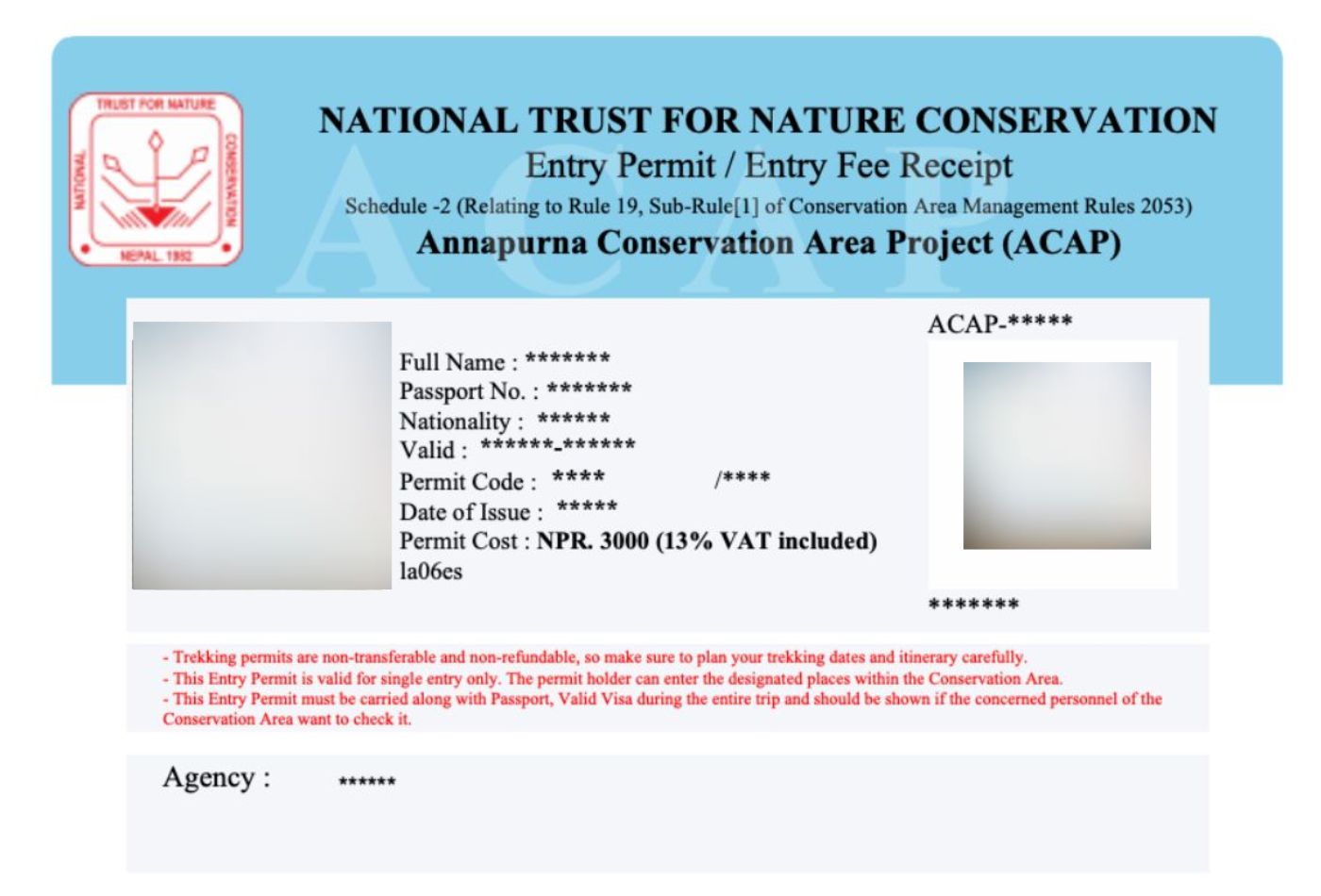
How Long is Mardi Trek?
The Mardi Himal Trek can typically be completed in four to five days, though it can be shortened to three days or extended up to seven days depending on fitness level, available time, and preferred trekking pace. The five-day itinerary is the most popular option, offering the ideal balance between comfort, enjoyment, and proper acclimatization.
Below is a more detailed breakdown of each duration:
- 3-Day Trek:
Best suited for experienced and physically fit trekkers who can manage seven to eight hours of walking per day. This option follows a faster pace with limited rest periods and minimal time for exploration. It is ideal for travelers on tight schedules who want to experience Mardi Himal within a short timeframe. - 4-Day Trek:
A moderate-paced itinerary preferred by many trekkers. Expect six to seven hours of trekking daily with some challenging ascents. This version provides enough time to enjoy the scenery while maintaining a steady rhythm. It’s a great choice for those with decent fitness looking for a compact yet fulfilling adventure. - 5-Day Trek:
The most recommended and balanced option for the Mardi Himal route. It allows trekkers to move at a comfortable pace, enjoy the surrounding landscapes, and adapt naturally to the altitude. This duration is particularly suitable for first-time or beginner trekkers who want a rewarding experience without feeling rushed. - 6–7 Day Trek:
Ideal for those who prefer a more relaxed journey with ample time for acclimatization and photography. Extending the trek to six or seven days reduces daily walking hours and allows for longer stays at scenic spots like Low Camp, High Camp, or the Upper Viewpoint. It is also recommended for trekkers who enjoy a slower, more immersive mountain experience.
The 9-day Mardi Himal Trek with Nepal Hiking Team is designed for travelers seeking a rewarding Himalayan adventure with a balanced pace. Out of the nine days, five are dedicated to trekking, allowing ample time for travel, rest, and exploration in Pokhara. This itinerary offers a perfect combination of scenic mountain walks, cultural encounters, and comfortable acclimatization within the Annapurna region.
Food and water on the Mardi Himal Trek
Meals along the Mardi Himal Trek are thoughtfully prepared to provide warmth, energy, and comfort across changing altitudes. Teahouses serve both local Nepali dishes and familiar international meals, ensuring variety and nourishment throughout the journey. Dal Bhat remains the signature and most reliable choice. This classic combination of rice, lentil soup, vegetables, and pickles delivers a balanced mix of carbohydrates and protein. Its unlimited refills make it especially suitable for trekkers covering long daily distances.
Breakfasts are hearty and designed for stamina. Trekkers often choose porridge, eggs, Tibetan bread, or pancakes paired with tea or coffee. These meals supply slow-releasing carbohydrates and protein, ensuring sustained energy for morning climbs. As the trail ascends, food options become simpler since fresh supplies are harder to transport. Despite this, teahouses maintain high standards of preparation and hospitality. Many trekkers prefer lighter evening dishes such as garlic soup, vegetable noodle soup, or boiled potatoes, which support digestion and help with acclimatisation.
Prices increase gradually with altitude due to the cost of carrying ingredients to higher camps. Still, the meals remain wholesome, fresh, and satisfying. Each plate reflects the warmth of mountain hospitality and the commitment of local families who keep trekkers well-fed even in remote conditions.

Water management is essential on the Mardi Himal Trek, where altitude, physical effort, and dry air increase fluid loss. Staying well-hydrated supports both comfort and acclimatisation.
Here are the main water options along the trail:
- Bottled mineral water – Available up to Rest Camp, usually costing between 100 and 150 NPR per bottle. It is convenient but generates plastic waste, so switching to refills above Rest Camp is encouraged.
- Boiled or filtered water – Common after Rest Camp, where teahouses offer safe refill options. Prices range from 150 NPR per litre near Rest Camp to around 300 NPR per litre at High Camp, reflecting the effort needed to provide clean water at altitude.
- Tap or spring water – Found near villages and along the trail. Although it may look clean, it should always be treated with purification tablets, a UV SteriPEN, or a portable filter before drinking.
Hot water is also available in most teahouses, served in thermoses or bottles for a small fee. Many trekkers prefer hot water in the early mornings or cold evenings, as it helps maintain warmth and hydration in freezing conditions.
You can explore more about food and water on the Mardi Himal Trek in the Mardi Himal Trek Food and Water Guide, which also features the real food menu from High Camp, the highest overnight stop on the route.
Accommodation for Mardi Himal Trekking
Accommodation along the Mardi Himal Trek is simple, comfortable, and deeply rooted in the local culture. Lodges and teahouses typically charge either per room or per bed, depending on availability and the elevation. As you ascend higher, facilities become more basic and rustic, reflecting the remoteness of the area. Most rooms are dormitory-style, furnished with two to four single beds, and equipped with warm blankets. However, adding extra layers such as your down jacket or a sleeping bag is highly recommended for warmth, especially at High Camp, where temperatures drop significantly at night.
The teahouses are family-run establishments, operated mainly by Gurung locals who take great pride in their hospitality. Staying in these teahouses not only offers you a warm, homely atmosphere but also provides an opportunity to experience authentic Nepali culture. Meals are freshly prepared with care and love, often using locally sourced ingredients. Dining in these small family kitchens gives trekkers a genuine taste of life in the mountains.
Electricity and Wi-Fi are available in most lodges up to High Camp, but both are solar-powered and can be limited during nighttime or cloudy days. Charging points are typically found in the main dining hall rather than in individual rooms, so it’s best to charge your devices while socializing or having meals. Wi-Fi connectivity is usually restricted to the common dining area and may be unreliable during poor weather conditions.
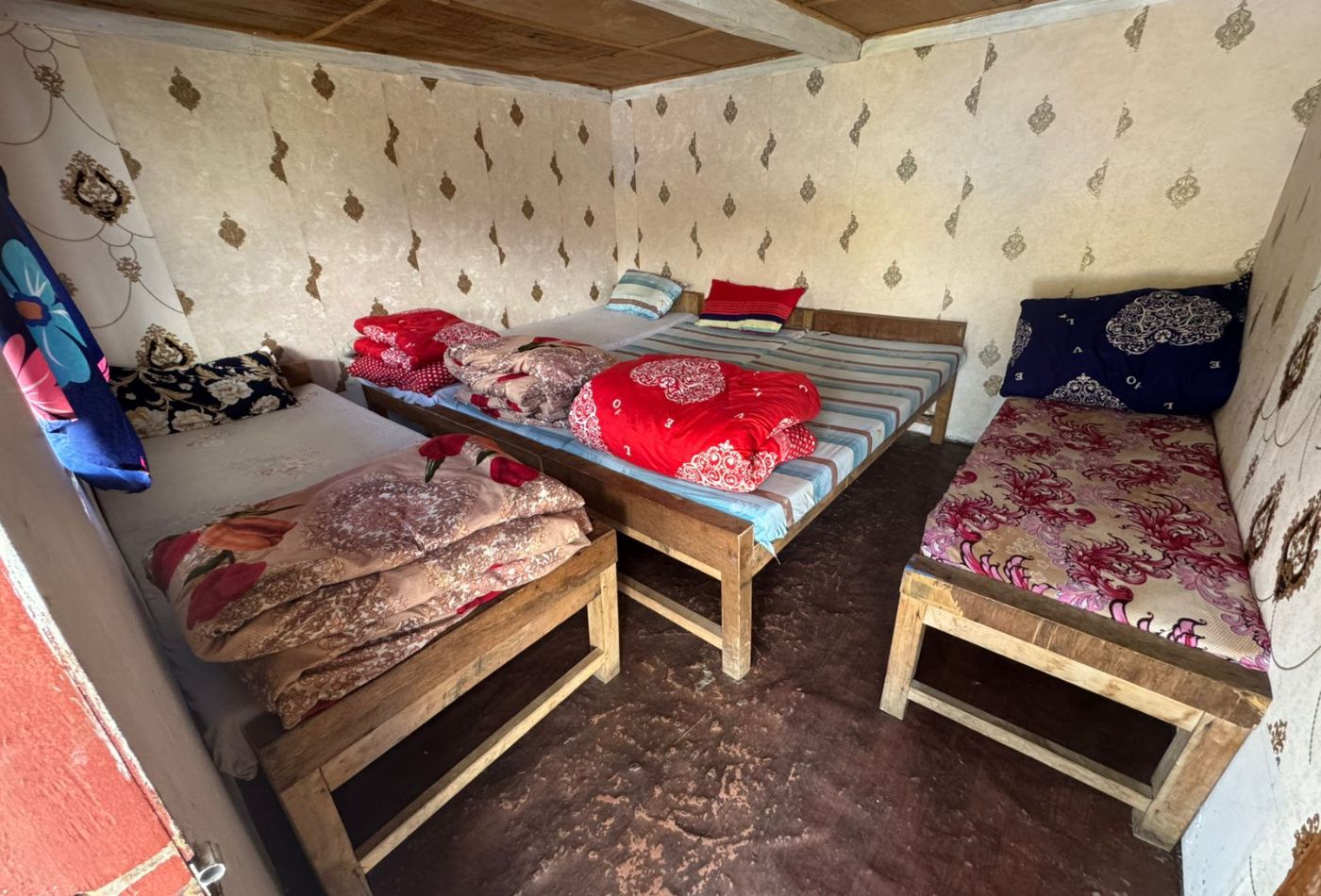
When making the final ascent to the Upper Viewpoint or Mardi Himal Base Camp, trekkers usually leave their main bags at the teahouse in High Camp. The lodge owners ensure that your belongings are kept safe and secure until you return.
Accommodation on this trek plays a vital role in supporting the local mountain economy, as every stay directly contributes to the livelihood of families in the Annapurna region.
In terms of meals, the menu remains relatively consistent throughout the trail, featuring popular dishes such as dal bhat, noodles, fried rice, soups, pancakes, and tea or coffee. While the options stay the same, prices increase with altitude due to the effort required to transport ingredients to higher villages.
Staying in these teahouses and sharing meals with the locals makes the Mardi Himal Trek not only a scenic adventure but also a heartfelt cultural experience.
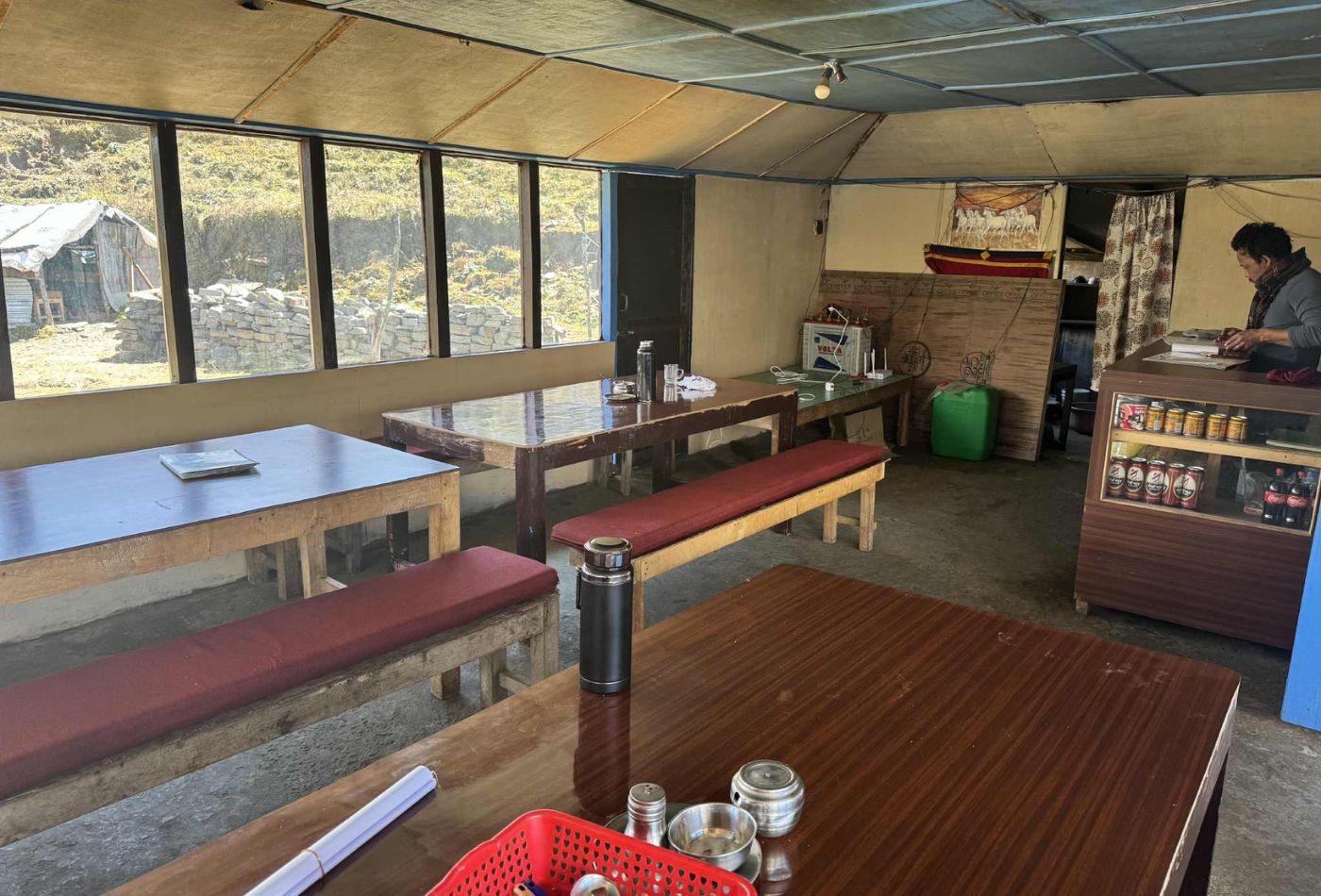
Money during Mardi Himal Trek
There are several small shops and teahouses along the Mardi Himal Trek, even up to the Upper Viewpoint, where trekkers can buy snacks, tea, and basic supplies. Prices tend to increase with altitude due to the difficulty of transporting goods to higher elevations. You can make small purchases along the way to enjoy local treats or warm beverages during your trek.
Please note that only Nepalese Rupees (NPR) are accepted in the highlands. Cash is required for all transactions, as mobile banking and digital payments are often unreliable in remote areas. There are no ATMs along the Mardi Himal trail, so make sure to withdraw enough cash in Kathmandu or Pokhara before starting your trek.
Currency exchange services are also available only in Kathmandu and Pokhara, and exchanging money at higher elevations is not recommended. Plan your budget and expenses carefully to ensure you have sufficient funds for food, accommodation, and personal purchases throughout your journey in the mountains.
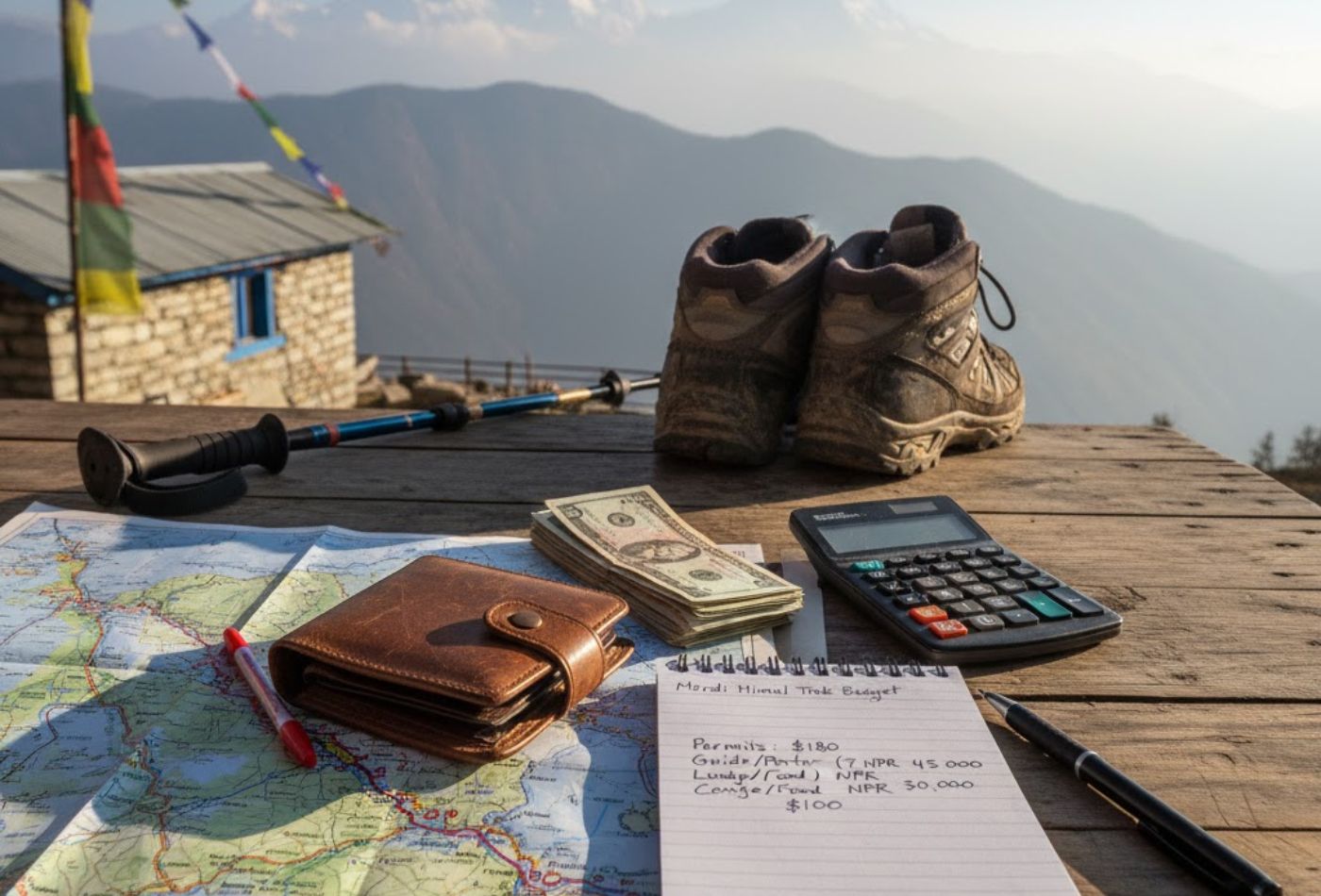
If you are trekking the Mardi Himal Trek with Nepal Hiking Team, your package includes three daily meals (breakfast, lunch, and dinner) along with tea or coffee, as well as all accommodation, ground transportation, a duffel bag, a down jacket, and an Annapurna region map. All of these are covered within the package price.
You will, however, need to pay separately for bottled or boiled water, extra snacks, and additional meals not listed in the package. Essential trekking gear such as trekking poles and hiking shoes can be easily rented in Kathmandu or Pokhara before the trek begins.
For personal expenses, it is recommended to budget around NPR 20,000 to 25,000 per person for the 9-day Mardi Himal Trek. This estimate covers additional purchases, hot showers, Wi-Fi, or small souvenirs along the trail. Please keep in mind that actual expenses depend on your spending habits and preferences during the trek.
Encountering Mules at Mardi Himal Trek
Mules are hybrid animals born from a cross between a male donkey and a female horse. In Nepal, they are commonly known as Khachar and are widely used in mountain regions, including along the Mardi Himal Trek, for carrying goods and supplies to remote villages. Strong, sturdy, and sure-footed, mules can carry loads of up to 100 kilograms, making them perfectly suited for the steep and uneven Himalayan trails.
Mules are generally calm and hardworking but can occasionally act stubborn or defensive if startled. You can often hear them before you see them, as the bells around their necks create a rhythmic sound that echoes through the mountains. It is also common to find mule dung along the trail. Instead of being unpleasant, it should be seen as part of the natural mountain environment, a sign of life and local activity in the highlands.
During the trek, mules usually travel in groups of five to eight, guided by a herder. When you encounter them on narrow paths, step to the inner side of the trail and allow them to pass. They are well-trained and pose no danger if given space.
Mules can be easily distinguished from horses and donkeys. They have the long ears and short mane of a donkey, combined with the larger frame and muscular strength of a horse. Their endurance, balance, and adaptability make them ideal pack animals for Nepal’s rugged mountain terrain.
On the Mardi Himal Trek, mules are an essential part of the journey, symbolizing the traditional lifestyle and the hard work that keeps the mountain communities connected and thriving.
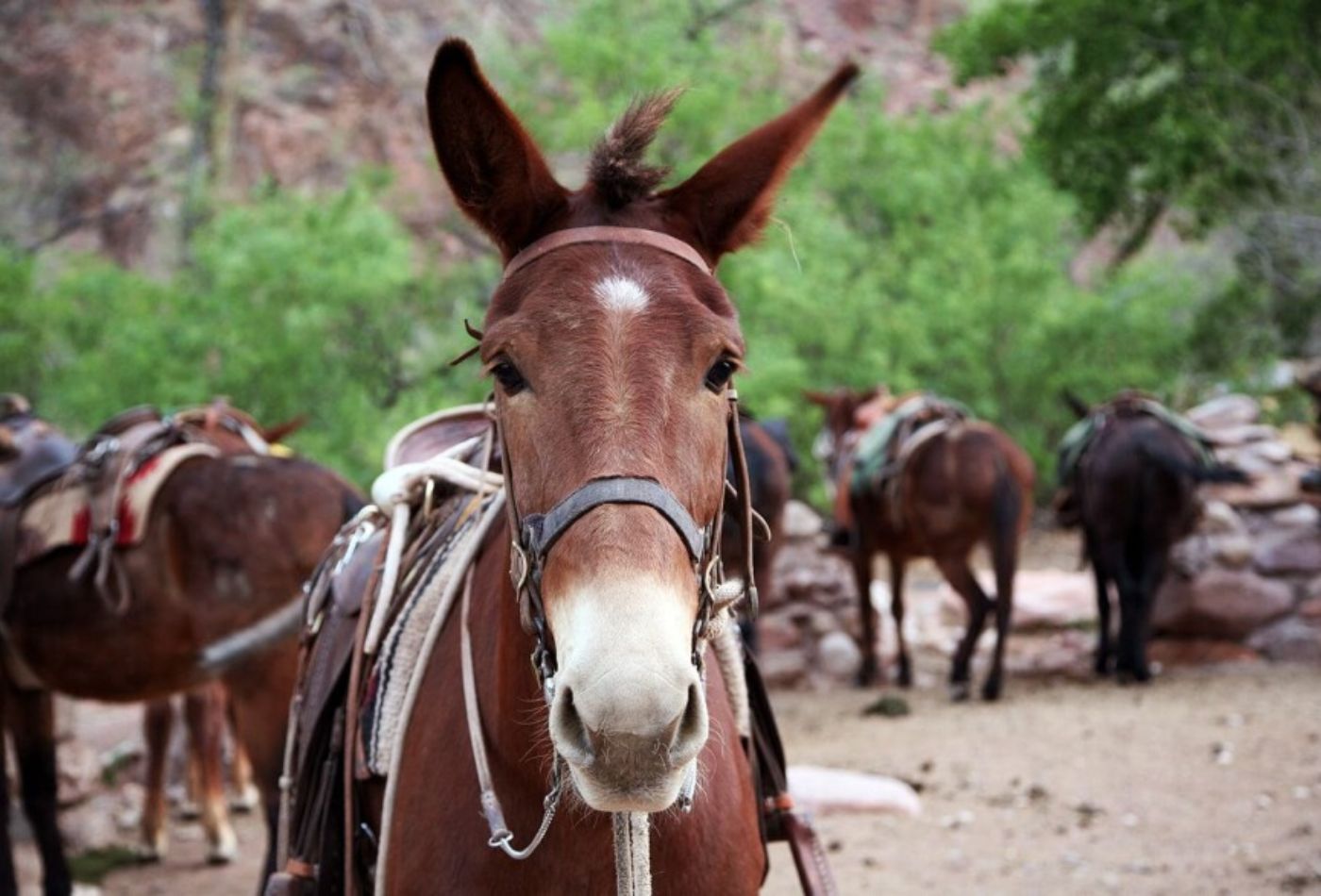
Solo Trekking for Mardi Himal Trek
Unlike restricted trekking regions such as the Manaslu Circuit or Upper Mustang, where a minimum of two trekkers is required to obtain a special permit, solo trekking on the Mardi Himal Trek is permitted throughout the year. This flexibility makes Mardi Himal one of the more accessible treks in Nepal, particularly for independent travelers seeking a short yet rewarding Himalayan adventure.
That said, solo trekking is not strongly recommended, especially for those unfamiliar with the region or high-altitude conditions. The trail, while well-marked in most parts, can become confusing in forested sections or during foggy weather near High Camp. Having a professional guide ensures that you stay on the right path, manage your pace safely, and receive timely guidance on altitude and weather changes. Guides are also trained to handle emergency situations and can quickly arrange assistance if needed.
Beyond safety, trekking with a guide or companion enriches your overall experience. A knowledgeable local guide can share insights into the Gurung culture, local traditions, and the spiritual significance of the Himalayas. They can help you interact meaningfully with villagers, order local food, and understand the mountain lifestyle on a deeper level. For solo travelers, having a guide also provides companionship and peace of mind on remote sections of the trail.
While the Mardi Himal Trek offers the freedom to travel independently, choosing to trek with a licensed guide or a trusted local agency like Nepal Hiking Team ensures a more secure, culturally engaging, and memorable adventure.
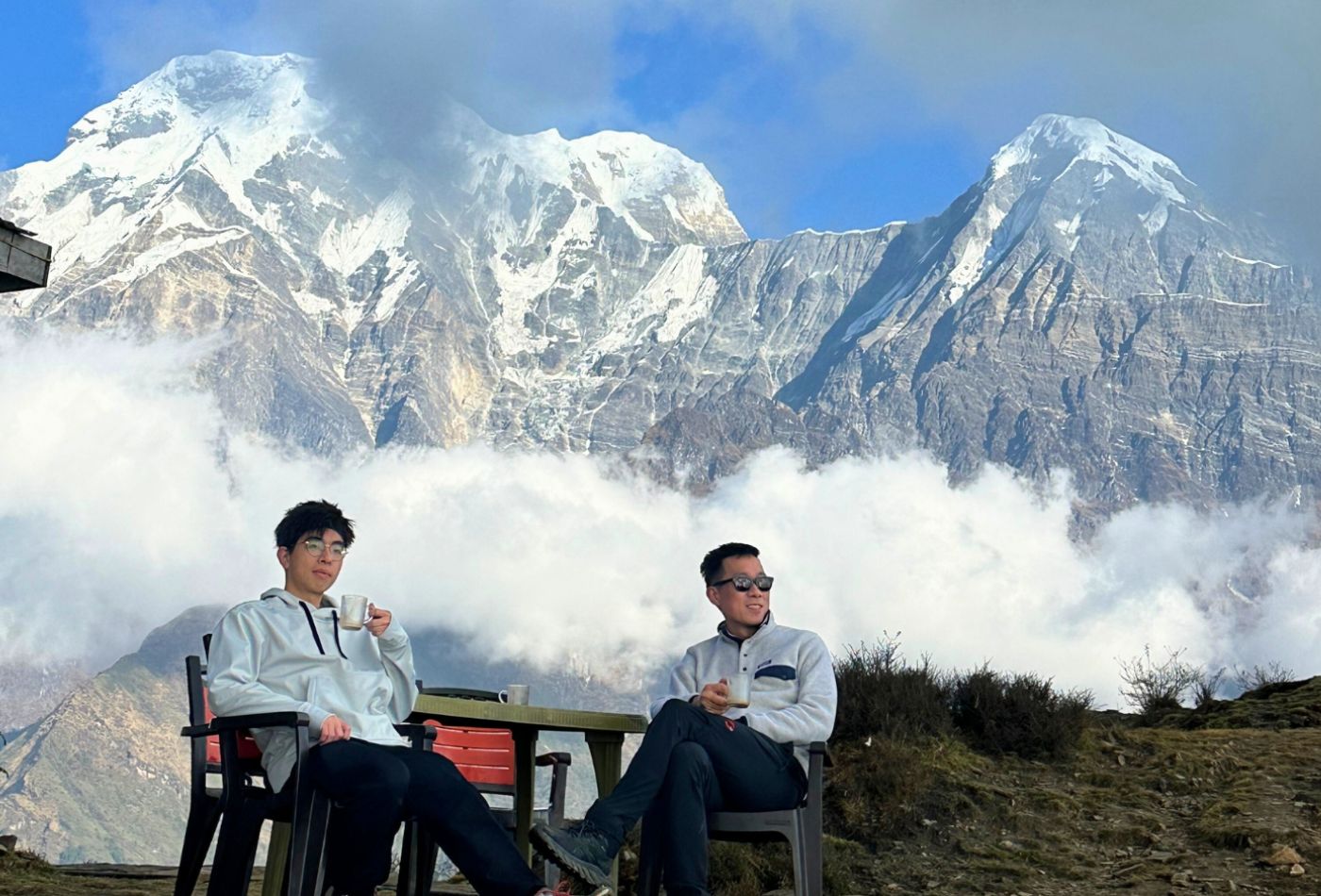
Restroom during Mardi Himal Trek
Throughout the Mardi Himal Trek, most teahouses and lodges provide non-flush squat toilets, while western-style washrooms are quite rare along the trail. Water is usually available in buckets and is often cold, especially at higher elevations. As the altitude increases, toilet and washing facilities become more basic, reflecting the remote mountain environment. Trekkers are advised to carry personal toiletries, wet wipes, and hand sanitizer for added comfort and hygiene during the journey. The restrooms along this trek are usually located outside the main accommodation area.
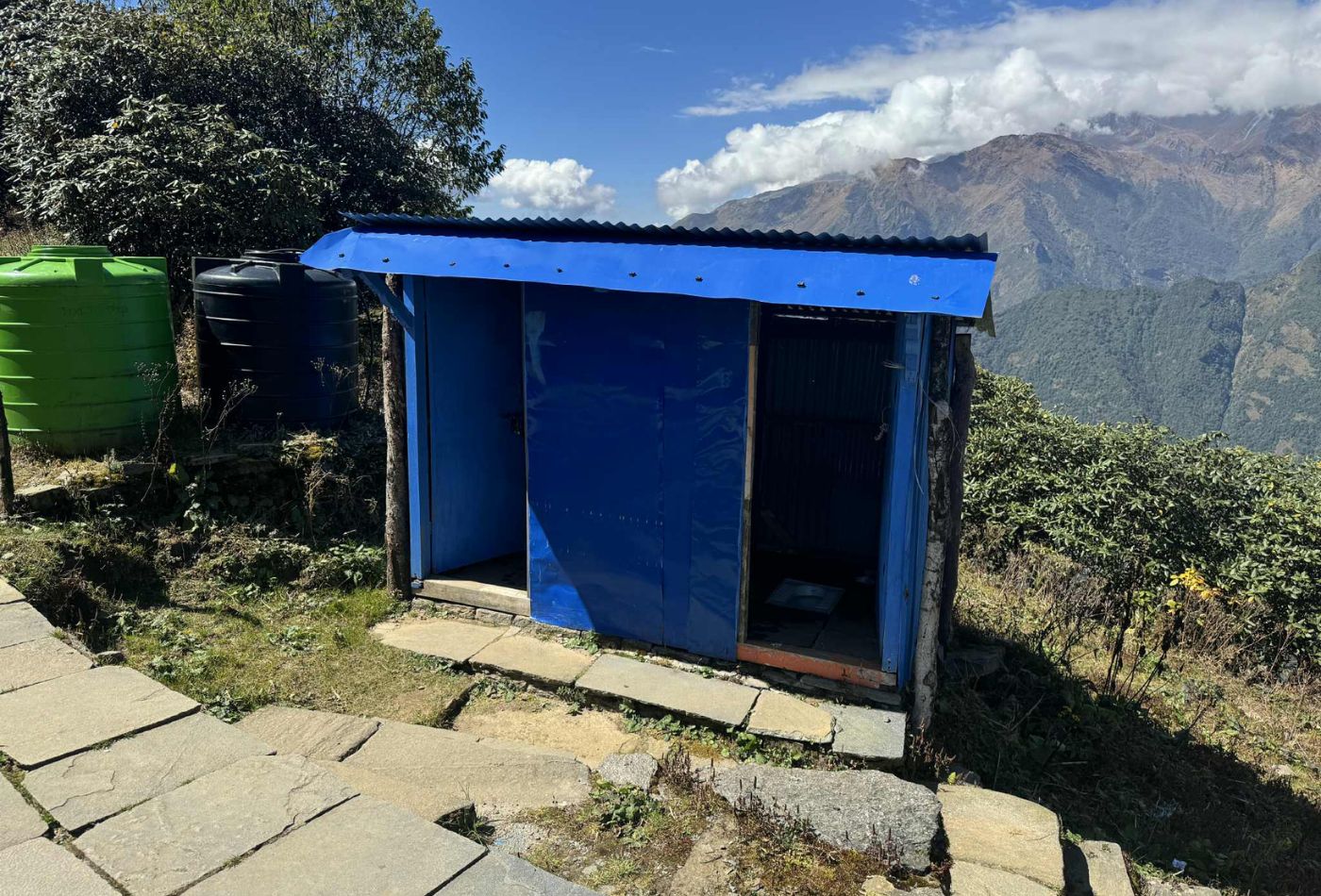
Hot Shower During Mardi Himal Trek
On the Mardi Himal Trek, hot showers are available at most teahouses up to High Camp. The cost typically ranges between 300 and 700 NPR, depending on the altitude and the lodge’s facilities.
Water for showers is usually heated in one of two ways: gas-powered or solar-powered systems. While both options are available, gas-heated showers tend to be more reliable, especially in higher areas where sunlight can be limited. A warm shower is a welcome comfort during the trek, helping you feel refreshed and re-energized after a day on the trail.

Trekking Alternatives to the Mardi Himal Trek
The Mardi Himal Trek is well-known for its beginner-friendly trail and flexible itinerary, making it a perfect choice for those seeking a short yet rewarding Himalayan experience. However, it is not the only trek in the region that offers such dramatic variation in landscapes within a compact timeframe. Below are some of the most popular trekking alternatives to the Mardi Himal Trek within the Annapurna region, each offering its own distinct charm and adventure.
Annapurna Base Camp Trek
The Annapurna Base Camp Trek is one of Nepal’s most celebrated routes, combining magnificent mountain views, cultural diversity, and a moderate level of adventure. The trail meanders through terraced farmlands, dense rhododendron forests, and traditional Gurung and Magar settlements before reaching the base of the towering Annapurna I (8,091 m). At an elevation of 4,130 meters, the base camp offers a stunning 360-degree panorama of peaks, including Machhapuchhre and Hiunchuli. This trek provides the perfect balance between accessibility and a rewarding Himalayan experience.
Ghorepani Poon Hill Trek
The Ghorepani Poon Hill Trek is one of the most popular short routes in the Annapurna region, ideal for beginner trekkers or those looking for a comfortable Himalayan experience. The trail leads through vibrant rhododendron forests, traditional villages, and gentle mountain ridges before reaching Poon Hill (3,210 m), a world-famous viewpoint for sunrise over the Annapurna and Dhaulagiri ranges. It is a culturally rich journey filled with warm local hospitality and some of the finest Himalayan landscapes.
Mohare Danda Trek
The Mohare Danda Trek offers a quieter and more peaceful experience, situated between the Annapurna and Dhaulagiri ranges. It provides equally stunning views to Poon Hill but with fewer crowds, creating an atmosphere of tranquility and connection with nature. The highest point, Mohare Danda (3,313 m), rewards trekkers with spectacular sunrise and sunset views over the snowcapped Himalayas. This route promotes community-based tourism, where local families welcome guests into their homes, offering genuine hospitality and an authentic cultural experience.
Trekking Routes to Mardi Himal Trek
There are several route variations available for the Mardi Himal Trek, each offering a unique perspective of the Annapurna region. All itineraries begin with either a drive or a short flight from Kathmandu to Pokhara, followed by a scenic drive to the chosen trailhead. The trek can be customised based on your preferred starting point, ending point, and any additional destinations you wish to explore.
Starting from Dhampus
- A classic route beginning from a beautiful village, about 45 minutes to one hour of driving from Pokhara.
- The road is smooth and scenic, creating a pleasant start to your adventure.
- From Dhampus, the trail climbs through forests and settlements toward Pothana and Deurali, where the Mardi Himal route officially begins.
Starting from Kande or Phedi
- Another popular trailhead that offers access to Australian Camp for panoramic Annapurna views.
- From Australian Camp, the path reconnects with the main Mardi Himal route at Deurali.
- The drive is slightly longer than to Dhampus but offers equally scenic views of the mountains and countryside.
Mardi Himal with Annapurna Base Camp (ABC) Extension
- Ideal for a longer adventure that combines two iconic routes.
- After reaching the Upper Viewpoint or Mardi Himal Base Camp, return via High Camp, Badal Danda, and Low Camp, then continue to Landruk.
- From Landruk, connect to Sinuwa and follow the trail to Annapurna Base Camp.
- Alternatively, link through Ghandruk and Tadapani for a slightly longer but richer experience.
Mardi Himal with Ghorepani Poon Hill Extension
- Enjoy the famous sunrise over the Annapurna and Dhaulagiri ranges from Poon Hill.
- Trek onward through Tadapani and Ghandruk and connect to the Mardi Himal trail at Landruk.
Thanks to its accessibility and flexible route options, the Mardi Himal Trek is one of the most customizable adventures in the Annapurna region. Whether you prefer a short, scenic escape or a longer, more immersive journey, this trek can be tailored to match your interests and timeframe.
In the 9-day Mardi Himal Trek package offered by Nepal Hiking Team, travellers journey between Kathmandu and Pokhara by comfortable tourist bus. For those who prefer a faster, more scenic option, the trip can be upgraded to a domestic flight for an additional USD 115 one-way.
The trek officially begins from Dhampus, a charming hillside village reached after a short drive from Pokhara. From there, the trail leads through Pothana, where the Annapurna Conservation Area Permit (ACAP) is first checked, before continuing toward Pitham Deurali, marking the start of the Mardi Himal route.
Over the following days, trekkers gradually ascend through rhododendron forests and open ridges to reach High Camp, the highest overnight point of the trek at 3,550 meters. This elevation is considered safe for well-acclimatised and physically fit trekkers. From High Camp, most travellers hike to the Upper Viewpoint, which offers panoramic views of Machhapuchhre (Fishtail) and the Annapurna range. For those seeking an extra challenge, the journey can be extended to the Mardi Himal Base Camp at approximately 4,500 meters.
The descent follows a scenic route from High Camp to Badal Danda, then through Low Camp and onward to Siding Village. Instead of retracing the trail toward Forest Camp, the route to Siding offers a more authentic cultural experience, with opportunities to interact with Gurung locals known for their warmth and hospitality. After a relaxing lunch in Siding, trekkers return to Pokhara by private four-wheel jeep.
As an optional extension, the trek can continue from Siding to Lwang Village, offering deeper insight into Gurung culture and rural mountain life. This short modification adds both cultural value and scenic variety to the overall experience, making the Mardi Himal Trek an ideal blend of nature, adventure, and authentic Nepali hospitality.
Guides and Porters for Mardi Himal Trek
Guides and porters play an essential role in making the Mardi Himal Trek comfortable, safe, and memorable. They are more than just trekking staff; they become trusted companions who help you navigate the trails, share local stories, and ensure a smooth journey through the scenic hills and villages of the Annapurna region.
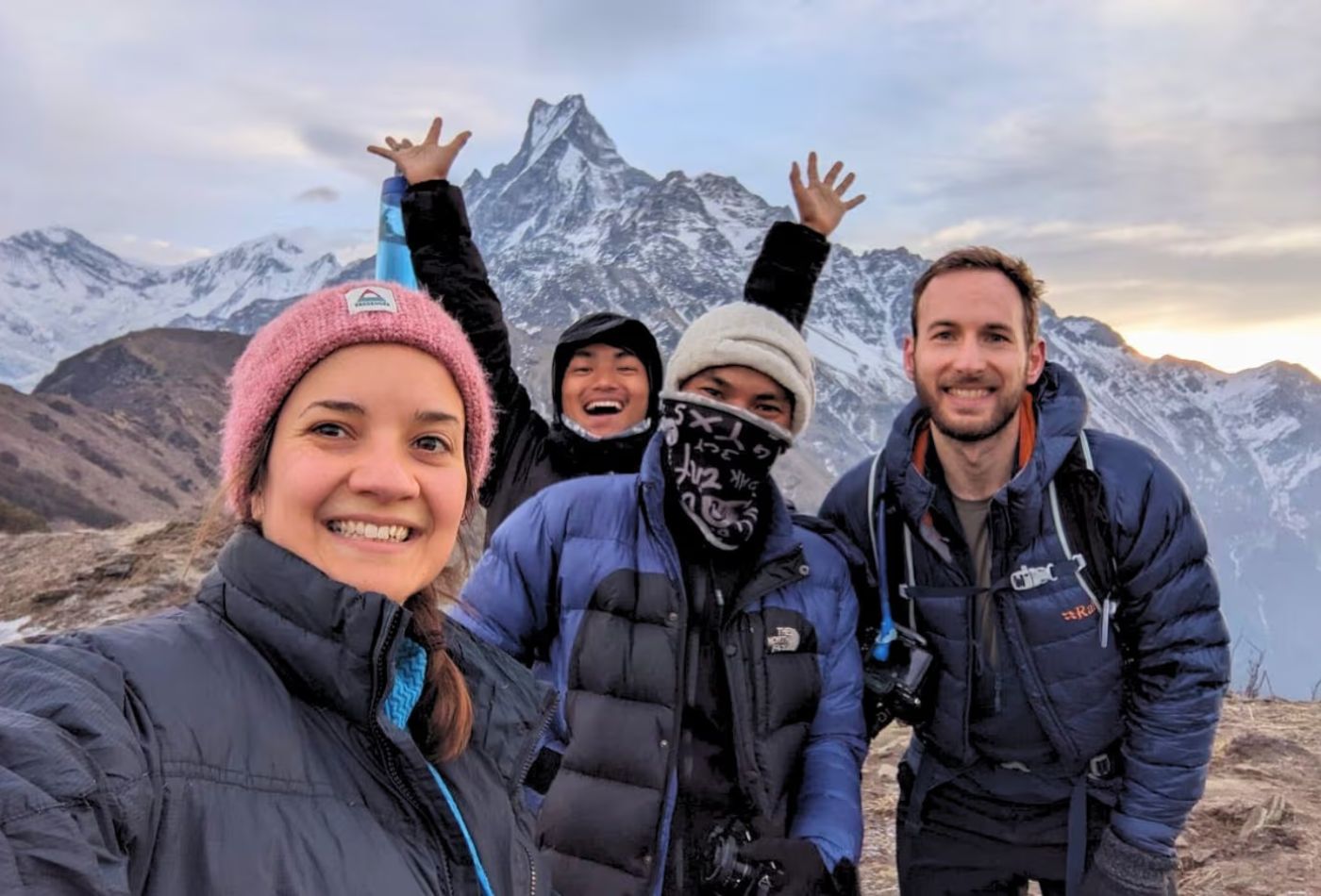
Although the Mardi Himal Trek does not legally require a government-licensed guide, having one greatly enhances your experience. The route includes forested paths, steep ascents, and varying weather conditions that can challenge even experienced trekkers. A qualified guide not only ensures your safety but also helps you understand the rich culture, lifestyle, and traditions of the Gurung communities along the trail. Their local expertise adds depth and confidence to every step of the journey.
Porters are the true backbone of the Mardi Himal Trek. They carry your main luggage, allowing you to trek comfortably with only a light daypack. Each porter typically carries up to 25 kilograms, easing the physical strain on travellers and helping maintain a steady pace throughout the trek. Their hard work and dedication allow you to fully enjoy the breathtaking views of Machhapuchhre and the mountains' peaceful beauty.
With Nepal Hiking Team, your Mardi Himal Trek experience is supported by licensed guides and insured porters who are trained, reliable, and deeply familiar with the region. We assign one porter for every two trekkers, allowing each traveller up to 12.5 kilograms of luggage. Our guides are fluent in English, excellent communicators, and dedicated to ensuring a safe and enjoyable trekking experience. Every member of our team is fairly treated, insured, and respected, making your adventure not only well-organised but also ethically operated.
Travel Insurance for Mardi Himal Trek
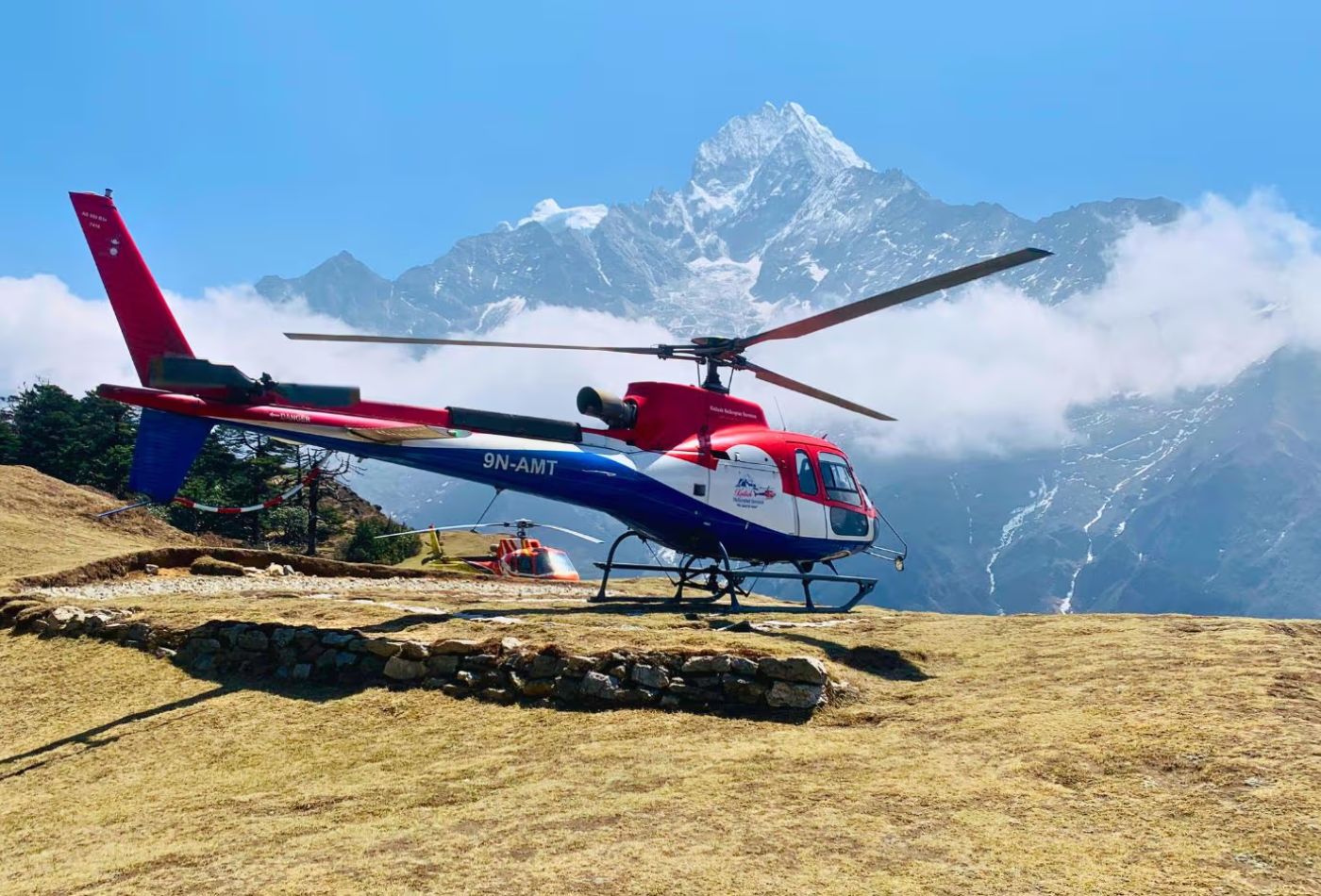
Travel insurance is mandatory for anyone trekking in Nepal. For the Mardi Himal Trek, being insured through a reliable travel agency is essential.
The highest scheduled point on the route is the Mardi Himal Upper Viewpoint at 4,200 meters. Some trekkers continue to Mardi Himal Base Camp at 4,500 meters. Choose a policy that covers you up to at least 4,500 meters.
Select your insurance carefully. Make sure your policy includes the following for the Mardi Himal Trek:
- High-altitude medical coverage up to 4,500 meters
- Emergency helicopter evacuation for altitude sickness or medical emergencies
- Trip cancellation or interruption protection
- Lost or damaged baggage coverage
- Medical and hospital expenses while in Nepal
The right insurance provides peace of mind, letting you focus on the experience and the views.
Mardi Himal Trek Concluding Notes - Nepal Hiking Team
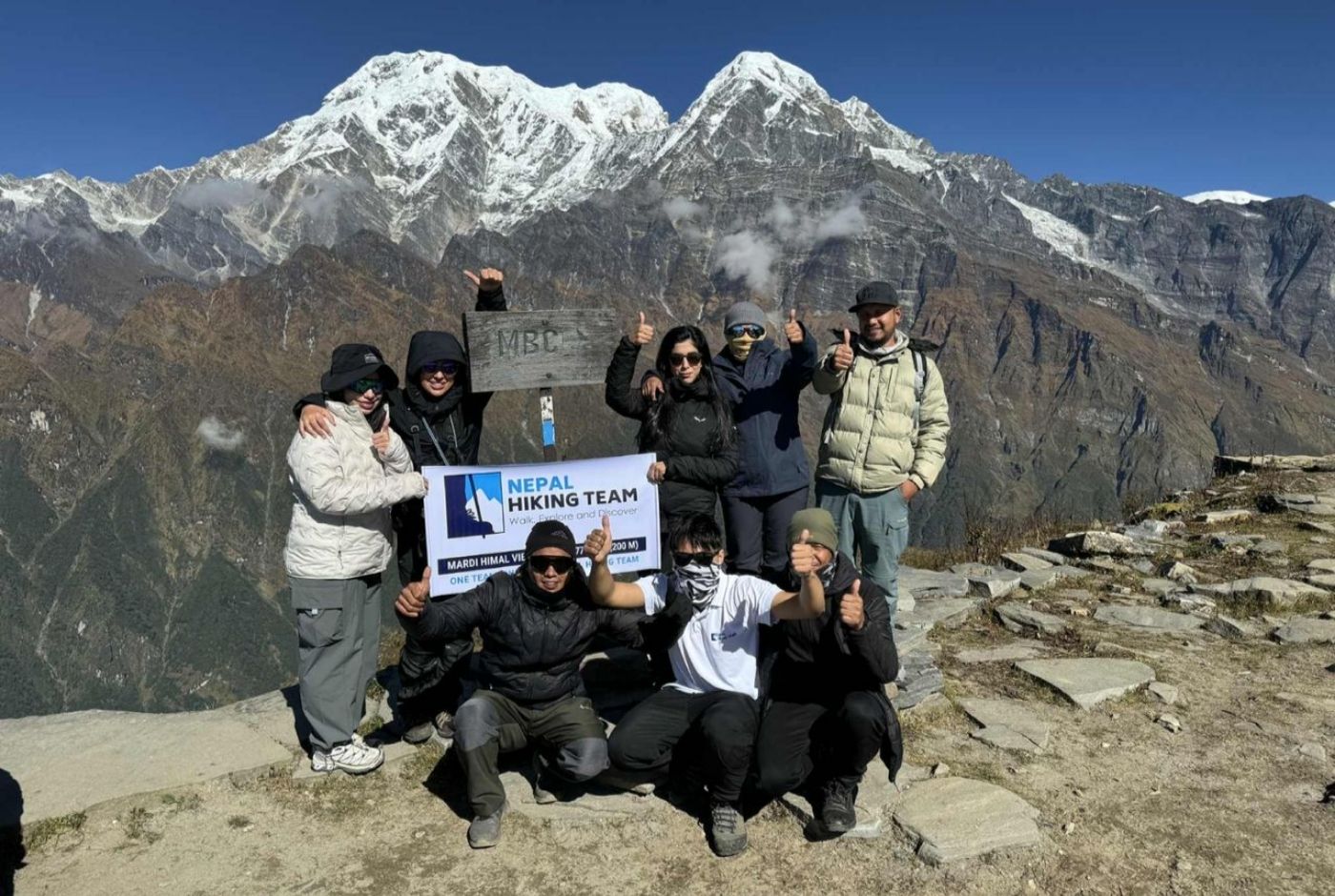
The Mardi Himal Trek is more than just a journey into the Annapurna region. It is an intimate encounter with Nepal’s natural beauty and mountain culture. At Nepal Hiking Team, we have crafted a 9-day Mardi Himal Trek package that captures the essence of this hidden gem while ensuring every traveller enjoys comfort, safety, and authentic local experiences.
Our itineraries are thoughtfully designed yet flexible, allowing you to adjust according to your pace and preferences. From handpicked teahouses that offer genuine Nepali hospitality to experienced local guides who share deep insights about the Himalayas, every element of the journey is carefully managed. You will walk through lush rhododendron forests, admire breathtaking views of Machhapuchhre, and feel the peaceful rhythm of the mountains.
Choosing Nepal Hiking Team means choosing a reliable partner for your adventure, one that prioritises your comfort, safety, and satisfaction from start to finish. Whether you are new to trekking or a seasoned traveller, our dedicated team ensures every step feels meaningful and memorable.
Join us on the Mardi Himal Trek and experience the true spirit of Nepal through the care, expertise, and warmth that define Nepal Hiking Team.
